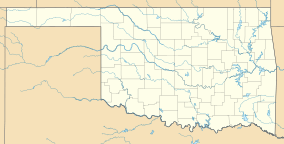Alabaster Caverns State Park facts for kids
Quick facts for kids Alabaster Caverns State Park |
|
|---|---|
| Location | Woodward County, Oklahoma, United States |
| Nearest city | Freedom, Oklahoma |
| Area | 200 acres (81 ha) |
| Established | 1956 |
| Visitors | 24,706 (in FY 2016) |
| Governing body | Oklahoma Tourism and Recreation Department |
Alabaster Caverns State Park is a special park in Oklahoma, USA. It's about 4.5 miles (7.2 km) south of a town called Freedom, Oklahoma. This park is famous for having the world's largest natural gypsum cave that you can visit!
Gypsum is a soft mineral. The cave is mostly made of a beautiful type of gypsum called alabaster. You can find pink, white, and even rare black alabaster here. Black alabaster is super special because it's only found in three places on Earth: Oklahoma, Italy, and China. You can also see cool selenite crystals in the cave.
The park is about 200-acre (0.81 km2) big. Many people visit each year to explore the amazing underground world.
Contents
History of Alabaster Caverns
How the Caves Formed
Millions of years ago, about 200 million years ago, a huge sea covered this part of North America. Over time, the water dried up. It left behind thick layers of minerals, especially alabaster. Later, the earth moved and pushed these mineral layers closer to the surface.
Then, water streams slowly carved tunnels through the soft rock. This created the amazing caverns we see today. Inside, you can find lots of selenite crystals, white and pink gypsum, and the rare black alabaster.
Early Discoveries and Public Tours
No one knows exactly when Alabaster Caverns were first found. But people know that outlaws used them as hiding spots in the 1800s. The first official exploration of the caves happened in 1898. This was after Hugh Litton settled in the area in 1893.
In the 1920s and 1930s, some people rented land around the caves. They offered limited tours and called them "bat caves." In 1939, a man from England named Charles Grass bought the land. He worked hard to fix up the caves and opened them for public tours. He was the one who gave them their current name, Alabaster Caverns.
Becoming a State Park
By 1952, Charles Grass was not well. A group of five business people from nearby Freedom, Oklahoma wanted the state of Oklahoma to buy the land. They worked with a railroad labor group to make this happen.
The state of Oklahoma bought 200 acres (81 ha) from Grass on September 1, 1953. They paid $34,000 for it. In 1956, the land officially became a state park. It was managed by the Oklahoma Planning and Resources Board. In the mid-1950s, the caves were even used as a place for people to hide in case of a nuclear attack.
Geology of the Caverns
What the Caves are Made Of
Alabaster Caverns State Park sits on very old rocks. These rocks are from the Permian Age, which was about 250 to 300 million years ago. The main cave goes about 0.75 miles (1,210 m) deep into the ground. It is about 60 feet (18 m) wide and 50 feet (15 m) high.
The main cavern splits into smaller caves and areas with large rocks. A small stream flows through the cavern all year. This stream gets water from other tunnels and from water dripping from the cave ceiling. Long ago, this river was much bigger. It could fill the whole cavern! You can see marks on the cave walls from the fast-flowing water.
Cave Temperature
The air inside the cavern stays cool and steady. The temperature is usually between 52˚F and 58˚F (about 11˚C to 14˚C) all year round.
Wildlife in the Caves
Meet the Bats!
Alabaster Caverns is home to five different kinds of bats. Some bats live alone, while others live in large groups. The cave is a perfect place for them to rest during the day. It's also where bats that don't migrate stay warm and safe during the winter.
One special type of bat is the Mexican free-tailed bat. These bats fly all the way from Mexico to Alabaster Caverns in the spring. They come here to have their babies. Then, in the fall, they fly back to Mexico.
Types of Bats Found Here
The different kinds of bats living in the cave are:
- The cave myotis
- The Western big-eared bat
- The eastern pipistrelle
- The Western big brown bat
- The Mexican free-tailed bat
Park staff count the bats each year. In a recent count, they found over 19,000 bats living in the caverns!
Fun Things to Do at Alabaster Caverns
Explore the Caves
The most popular activity is taking a guided tour of the cave. These tours happen every hour and last about 45 minutes. Each tour can have up to 40 people. The caves have lights and handrails to help you see and walk safely.
The walking tour is about 0.75 miles (1,210 m) long. You will need to go up or down about 330 steps. If you have trouble walking, breathing, or are afraid of small spaces, this tour might be difficult.
Other Activities
Besides cave tours, there are many other fun things to do at the park:
- Wild Caving: For those who want more adventure, you can go on special "wild caving" trips.
- Camping: You can set up a tent and camp overnight.
- Hiking Trails: Explore the park above ground on its hiking paths.
- Recreational Facilities: The park also has places to play, like horseshoe pits and volleyball courts.
Future of the Park
In 2017, the state of Oklahoma looked at closing some state parks. Alabaster Caverns State Park was on this list. This was because the state needed to save money. The park is still open, but its future is something people are watching closely.


